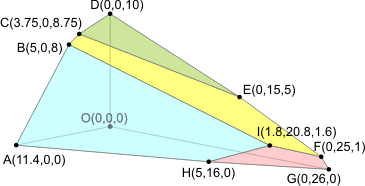Optimization

Professor:
Paul Wollan Thursday 10:30 - 12:00
Viale Regina Elena 295,
Office number G28
Class Times:
Tuesday, 14:00 - 17:00 in De Lollis 1
Wednesday, 17:00 - 19:00 in Castro Laurenziano 2L
Class 1:
Definitions: Graph, vertices, edges, flow in a graph, flow problem, residual graph, augmenting a flow.
Ford-Fulkerson algorithm for finding a flow. Combinatorial Optimization, pages 40 - 43
Definitions: Cut in a graph, capacity of a cut.
Class 2:
Theorem: maximum flow in a graph is equal to the minimum capacity of a cut. Combinatorial Optimization, Theorem 3.5
Edmonds-Karp algorithm for finding a flow. Proof that the Edmonds-Karp algorithm terminates in O(nm) augmentations of the flow. Combinatorial Optimization, pages 44 - 45
Class 3:
Completion of the proof of correctness of the Edmonds-Karp algorithm for finding a flow. Combinatorial Optimization, pages 44 - 45
Application of Max-flow/Min-cut: Menger's Theorem for edge disjoint paths.
Class 4:
Definitions: Linear program, objective function, constraints, feasible solution, optimal solution, Understanding and Using Linear Programming, Chapter 1.
Proposition: If a linear program has two distinct optimal solutions, then it has infinitely many optimal solutions.
Examples of Linear Programming: resource allocation, network flow. Understanding and Using Linear Programming, pages 11 - 15.
Class 5:
Example of Linear Programming: Largest disk in a convex polygon. Understanding and Using Linear Programming, pages 23 - 26.
Definitions: equation form of a linear program, slack variables, Basic feasible solution, basic variables, non-basic variables, feasible basis Understanding and Using Linear Programming, Chapter 4.
Proposition: A feasible solution x of a linear program in equational form is basic if and only if the columns of the matrix AK are linearly independent where K = { i : 1 ≤ i ≤ n, x i > 0}. Understanding and Using Linear Programming, Lemma 4.2.1.
Proposition: A feasible basis B defines a unique solution x to Ax = b, x ≥ 0. Understanding and Using Linear Programming, Proposition 4.2.2.
Class 6:
Theorem: Consider a linear program in equational form: max cT x subject to Ax = b, x ≥ 0.
If there exists at least one feasible solution and the objective function is bounded from above on the set of feasible solutions, then there exists an optimal solution.
If an optimal solution exists, then there exists a basic feasible solution which is optimal.
Class 7:
Definitions: Convex set, convex hull, convex combination, hyperplane, closed half-space, polyhedron, polytope, dimension of a polyhedron, vertex of a polyhedron, edge of a polyhedron Understanding and Using Linear Programming, Chapter 4.
Proposition: Let x1,...,xn in Rn. Let C be the convex hull of x1,...,xn and let C' be the set of convex combinations of x1,...,xn. Then C' = C. Understanding and Using Linear Programming, Proposition 4.3.1.
Theorem: Let P be the set of feasible solutions of a linear program in equational form. Then for all v ∈ P, v is a vertex of P if and only if v is a basic feasible solution to the linear program. Understanding and Using Linear Programming, Theorem 4.4.1.
Solution to the problem presented in class.
Class 8:
Example of the simplex method. Understanding and Using Linear Programming, pages 57 - 60.
Definitions: tableau, pivot. Understanding and Using Linear Programming, Chapter 5.
Proposition: For every feasible basis B of a linear program in equational form, the tableau T(B) is uniquely determined by B. Understanding and Using Linear Programming, Proposition 5.5.1.
Class 9:
Discussion: Unboundedness, infeasibility, and degeneracy in linear programs. See Understanding and Using Linear Programming, pages 61 - 65.
Class 10:
Examples of pivot rules, including Bland's rule.
Proposition: Algebraic conditions for the tableau T(B) for a feasible basis B which guarantee a pivot will result in a feasible basis B' = (B - {u}) ∪ {v}. Understanding and Using Linear Programming, Proposition 5.6.1.
Class 11:
Definitions: fickle variables.
Proposition: Let B1,...,Bk be feasible bases for a linear program in equational form such that T(B1) - T(B2) - ... - T(Bk) - T(B1) cycle with respect to a fixed pivoting rule. Let F be the set of indices of fickle variables in the cycle. Then there exists a basic feasible solution x such that for all j, 1 ≤ j ≤ k, x is the basic feasible solution associated to Bj and for all i such that xi ∈ F, xi = 0.
Theorem: The simplex method with pivoting according to Bland's rule does not cycle. Understanding and Using Linear Programming, Theorem 5.8.1.
Class 12:
Theorem: The simplex method with pivoting according to Bland's rule does not cycle. Understanding and Using Linear Programming, Theorem 5.8.1. (completion of the proof)
Class 13:
Example of a linear program which cycles for a specific pivot rule. See here for the explicit example as well as a discussion of the construction of such examples.
Definitions: dual linear program, primal linear program.
Proposition (Weak duality theorem): Consider the linear program: max cT x subject to Ax ≤ b, x ≥ 0 and its dual linear program min bT y subject to ATy ≥ c, y ≥ 0. If x and y are feasible solutions to the primal and dual linear programs, respectively, then cT x ≤ bT y. Understanding and Using Linear Programming, Theorem 6.1.1.
Class 14:
Discussion of the dual for a general linear program. See Understanding and Using Linear Programming, pages 84 - 86.
Proposition: Let P be a linear program and D the dual of P. Then the dual of D is the linear program P.
Theorem (Strong duality theorem): Consider the linear program (P): max cT x subject to Ax ≤ b, x ≥ 0 and its dual linear program (D) min bT y subject to ATy ≥ c, y ≥ 0. Exactly one of the following holds:
neither (P) nor (D) is feasible;
(P) is feasible and un bounded while (D) is not feasible;
(D) is feasible and un bounded while (P) is not feasible;
both (P) and (D) are feasible and in this case both are bounded and have the same optimum.